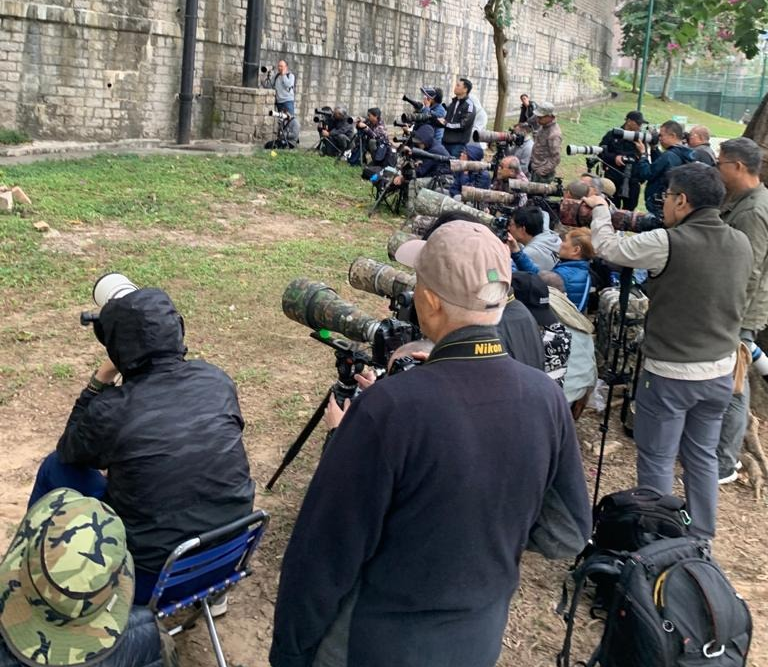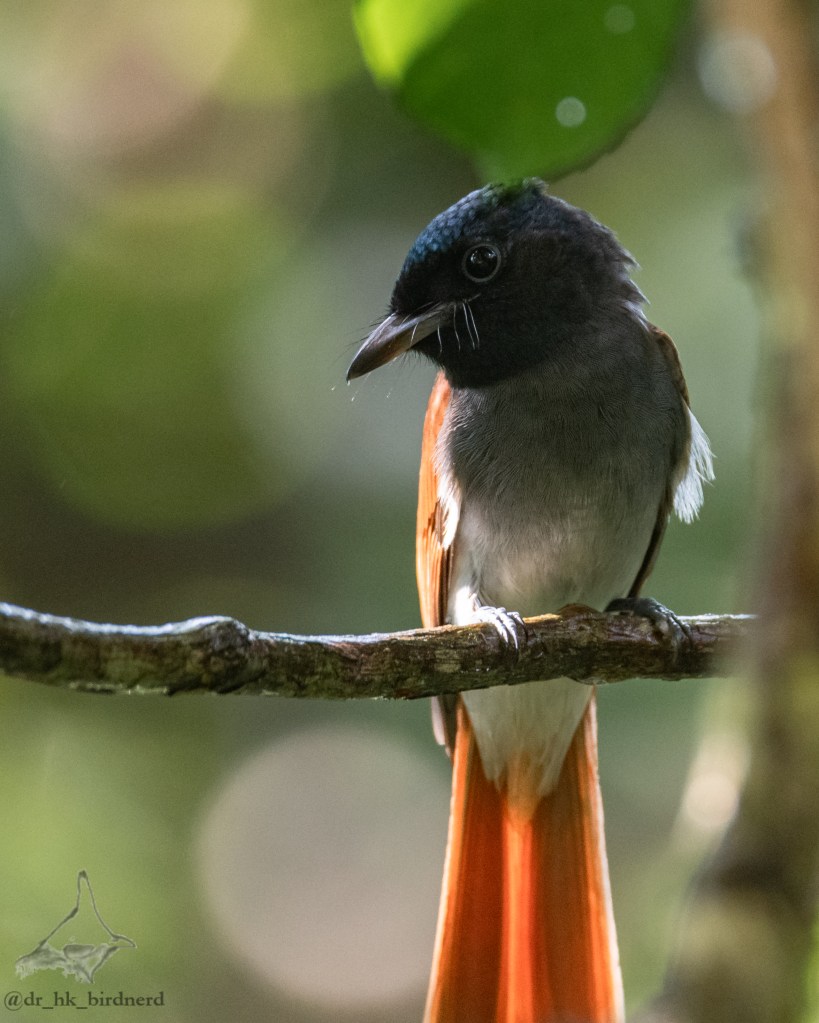Baiting is the practice of using bait—generally food—to attract wild birds. Sometimes it’s done fairly innocuously, while at other times, it can be both excessive and damaging. In Hong Kong, unfortunately, the latter is usually the case, and so I’m afraid that I’ll have to here defend the uncompromising view that baiting birds should not be done in Hong Kong.
Now before I go on, I should say that I have indeed in the past visited birding sites where birds were being baited, so feel free to call me a hypocrite. However, I don’t intend to visit any baiting sites moving forward, and posting this page serves as my public promise to that effect.

Types of baiting
There are a few different types of baiting strategies, depending upon the circumstances. We’ll divide these into stationary baiting and active baiting. These aren’t official categories, but they’ll do for now. They’re also not exhaustive, as some baiting methods fall in-between.
What I have in mind for stationary baiting is the rather common practice of feeding one’s local birds at a set, long-term location. Having a garden birdfeeder, for example, is what I would call an example of stationary baiting. Of course, most people in Hong Kong don’t have gardens, let alone a large enough garden or backyard ecosystem to successfully attract a resident population of birds, so it’s not really the common method of baiting here.
The other method that I call active baiting is the practice of 1) entering a public park, forest, nature reserve, or wherever there may be birds, 2) setting up a perch for the bird, and 3) using bait to attract the bird to that perch for the purpose of photos or viewing. This is the most common, and most problematic, method of baiting that occurs in Hong Kong, so we’ll focus on active baiting and leave stationary baiting to the side.
Problems with Active Baiting
I’ll mention 3 problems with active baiting in Hong Kong. These concerns are mostly ecological, having to do with the welfare of the birds themselves and with Hong Kong’s ecosystems generally.
First, active baiting harms the birds being baited. It causes birds to become acclimated to human feeding, thereby making them less fit to survive in their natural environment when the baiting is over. This may not seem like a big deal, but often birds being baited are what I call YASJ (Young And Stupid Juvenile) birds—an interesting first-winter male flycatcher, for example, is sure to draw a crowd of twitchers around a worm-populated perch. But juvenile birds are exceptionally at-risk of being harmed by active baiting, as there is no worse time in a bird’s life than when it’s supposed to be gaining valuable survival skills to be offering it free meals for days or even weeks on-end.
You may be tempted to think that stationary baiting shares this problem too, but one of the main features of stationary baiting is that the birdfeeder is intended to become part of the local ecosystem. Additionally, in most places that have birdfeeders, they are rather ubiquitous, and so it’s very likely that a neighborhood with one birdfeeder will have another nearby. For active baiting of the kind practiced in Hong Kong, the bait only lasts as long as the photographers are willing to put it there, and so when, after weeks of baiting, the bird returns to the perch to find its usual meal missing, it’s liable to be confused and at-risk of failing to get enough to eat.
Second, and relatedly, active baiting poses an especially severe risk to migrant species, which, of course, are the most-often baited birds in Hong Kong. This is because active bait perches distract and disrupt migrating birds by causing them to stay in Hong Kong longer than they intended or ought to stay, which can lead to birds failing to follow the weather patterns necessary to their migration. Additionally, if a migrant bird becomes too comfortable in an area of active baiting, then there’s a real possibility of it staying and breeding in Hong Kong, which could potentially damage Hong Kong’s already fragile and rather artificial ecosystems.
Third, active baiting teaches birds not to fear humans. Most birds make a point of avoiding humans, and for good reason. There’s no single greater threat to the survival of birds and all other wildlife than human beings and human activity—this much is obvious, and it seems obvious to most birds as well. However, when a bird is acclimated to human intervention, they put themselves at greater risk of coming across humans and being trapped by them. Especially in Hong Kong, many of the migrant species of interest to birders are exceptionally beautiful, and many are hunted and traded as cagebirds throughout the world. By teaching vulnerable migrant species not to fear humans, we risk putting even more birds and species at risk.
No bait, no wait—just get out there and bird!

Those are the biggest and I think most important reasons not to practice active baiting in Hong Kong, all of which are based in ecological concerns. But there are plenty of other non-ecological reasons not to do it.
It’s boring
It’s happened to me a few times before: I get a tip on a spot that’s holding a special bird and head over to see the bird only to find a crowd of photographers surrounding a single branch. I join the crow and find a spot to set up, the bird comes, I take my shots, and I’m ready to leave. I’ve sometimes spent mere minutes at a bird baiting spot when I haven’t had to wait very long for the bird to show up. There’s no sense of adventure, no sense of pride, no accomplishment of finding a special bird in the wild, without even offering the variety that can be supplied by backyard birdfeeders—it’s just no fun to me.
It’s crowded
As is the case with many activities in Hong Kong, birding crowds here can get downright silly sometimes in terms of size, and this is true whether or not the bird is being baited. Plenty of naturally-occurring birds-of-interest don’t actually need to be baited in order to draw a crowd. However, baiting a bird of interest will guarantee a crowd of some size.
Speaking personally, when I go birding, my intention is to get as far away from crowds as possible. The whole idea of going out birding by sitting in a crowd and waiting for a bird to artificially appear borders on offensive to me.
However, I don’t expect everyone to be as anti-social as I am, and I fully understand the value of this type of birding as a social activity to those who engage with it. However, this particular activity comes at the cost of the welfare of the birds themselves.
Doesn’t produce the best photos
Of course, baited birds often provide the clearest, closest photos you could possibly get of certain special species, but there’s more to a good wildlife photo than just the clarity alone.
Birds coming out to take bait from active baiting perches are usually concerned about 2 things: 1) overcoming their fear of the many humans and the many strange sounds luring her or him out in the open and 2) eating the free food. As such, the birds don’t typically do anything interesting when they actually come out to eat, instead nervously hopping along the perch, eating, and not doing much else.
Many of the best bird photos are the product of blind luck in the wild, of being at the right place at the right time, of being at the intersection between serious preparation and incredible opportunity. Photos of things like predation, mating rituals, flight, calls or singing—capturing any of these is more impressive than photographing a terrified bird sitting on a worm-covered log.
Conclusion
Active baiting is bad, especially in Hong Kong. It poses risks to the individual birds and by extension to Hong Kong’s fragile ecosystems and to bird species more generally. In addition to being bad, it’s also boring, crowded, and doesn’t produce the best photos.
Luckily, it’s perfectly possible in Hong Kong to see fabulous birds by purely natural means—namely, by exploring Hong Kong’s many parks and forests. Hong Kong’s wildlife appreciation community is full of enthusiastic people actively seeking out new ecological treasures throughout Hong Kong, and they know many reliable places to find exciting birds and wildlife without the need to practice active baiting. If you’re new to birding in Hong Kong, check out my page on birding in Hong Kong.
Better yet, check out the Hong Kong Birdwatching Society website, as well as the excellent website, Birding Hong Kong, which posts weekly reports from throughout the territory.

